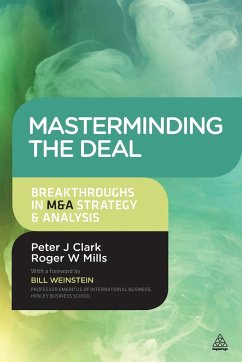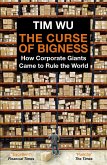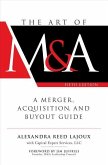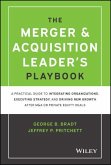- Broschiertes Buch
- Merkliste
- Auf die Merkliste
- Bewerten Bewerten
- Teilen
- Produkt teilen
- Produkterinnerung
- Produkterinnerung
Provides a unique assessment of M&A activity over the coming decade, looking at both the factors that shape successful deals, and reviewing the valuation techniques used to price them.
Andere Kunden interessierten sich auch für
![The Curse of Bigness The Curse of Bigness]() Tim Wu (Atlantic Books)The Curse of Bigness9,99 €
Tim Wu (Atlantic Books)The Curse of Bigness9,99 €![The Art of M&A: A Merger, Acquisition, and Buyout Guide The Art of M&A: A Merger, Acquisition, and Buyout Guide]() Alexandra Reed LajouxThe Art of M&A: A Merger, Acquisition, and Buyout Guide137,99 €
Alexandra Reed LajouxThe Art of M&A: A Merger, Acquisition, and Buyout Guide137,99 €![Corporate Finance Corporate Finance]() Terence C.M. TseCorporate Finance77,99 €
Terence C.M. TseCorporate Finance77,99 €![Corporate Finance Corporate Finance]() Terence C.M. TseCorporate Finance18,99 €
Terence C.M. TseCorporate Finance18,99 €![The Deal Paradox The Deal Paradox]() Michel DriessenThe Deal Paradox55,99 €
Michel DriessenThe Deal Paradox55,99 €![Go Do Deals Go Do Deals]() Jeremy HarbourGo Do Deals21,99 €
Jeremy HarbourGo Do Deals21,99 €![The Merger & Acquisition Leader's Playbook The Merger & Acquisition Leader's Playbook]() George B. Bradt (PrimeGenesis)The Merger & Acquisition Leader's Playbook46,99 €
George B. Bradt (PrimeGenesis)The Merger & Acquisition Leader's Playbook46,99 €-
-
-
Provides a unique assessment of M&A activity over the coming decade, looking at both the factors that shape successful deals, and reviewing the valuation techniques used to price them.
Hinweis: Dieser Artikel kann nur an eine deutsche Lieferadresse ausgeliefert werden.
Hinweis: Dieser Artikel kann nur an eine deutsche Lieferadresse ausgeliefert werden.
Produktdetails
- Produktdetails
- Verlag: Kogan Page Ltd
- Seitenzahl: 354
- Erscheinungstermin: 3. August 2013
- Englisch
- Abmessung: 234mm x 156mm x 20mm
- Gewicht: 538g
- ISBN-13: 9780749469528
- ISBN-10: 0749469528
- Artikelnr.: 37667362
- Herstellerkennzeichnung
- Libri GmbH
- Europaallee 1
- 36244 Bad Hersfeld
- gpsr@libri.de
- Verlag: Kogan Page Ltd
- Seitenzahl: 354
- Erscheinungstermin: 3. August 2013
- Englisch
- Abmessung: 234mm x 156mm x 20mm
- Gewicht: 538g
- ISBN-13: 9780749469528
- ISBN-10: 0749469528
- Artikelnr.: 37667362
- Herstellerkennzeichnung
- Libri GmbH
- Europaallee 1
- 36244 Bad Hersfeld
- gpsr@libri.de
Peter J Clark is a management consultant and company advisor with his own international firm. He is also Senior Teaching Fellow at University College London with the Department of Management Science and Innovation, where he teaches finance and M&A. Peter has more than 20 years' experience in M&A including target search, bid-sale advisory and merger divestiture strategy, involving more than $3bn in transactions. One of his previous books, Beyond the Deal, received mention as a book of the month by the Wall Street Journal. Rogers W Mills is an advisor to companies, banks, investors and sovereign-focused organizations. He has significant expertise in financial strategy, mergers, acquisitions and joint ventures, IPOs and related areas of corporate value improvement. He is Emeritus Professor of Finance and Accounting at Henley Business School, University of Reading, and most recently was Professor of Fundamental Analysis and Business Valuation at the VU University in Amsterdam.
List of figures and tables
About the authors
Foreword by Bill Weinstein
Preface
Introduction
01 The next merger boom is already here
1.1 Business-merger waves: patterns, theories on causes, issues
1.2 Four post-1980 four business-merger waves, four phases
1.3 The fourth (and final?) post-1980 wave is already underway
1.4 Merger wave issue I: (T)APP-synergy divergence as the wave progresses
1.5 Merger wave issue II: whipsaw-merger market entry and exit missteps
02 Debunking the six merger fallacies that destroy value
2.1 Increased understanding of historical merger failure means that
would-be acquiring firms are more inclined to avoid mergers
2.2 Significant increases to target company's debt levels do not
significantly reduce the probability of the related deal's success
2.3 The heroic figure in the acquisition drama is the all-conquering
acquirer, while shareholders of the acquired company are victims, with
their firms accurately depicted as led by underperforming managers
2.4 There is no inherent conflict of interest between dealmakers and other
parties compensated on the basis of fees earned upon deal closure, and the
interests of acquiring firms' shareholders
2.5 Price-to-earnings and similar multiples techniques are the leading
merger valuation methodologies
2.6 Stories and process: PMI success is primarily a matter of sound process
and responsive organization
03 Criteria: First, get the merger valuation methodology right
3.1 You can't manage what you can't measure especially when it comes to M&A
3.2 Criteria-setters: preeminence of continuing shareholders of the
acquiring firm
3.3 Overview: four alternative merger valuation methods
3.4 Event studies (ES): exceeding the limits of rational market theory
3.5 Total shareholder return (TSR): most appropriate for round turn
financial acquirers?
3.6 Value gap (VS): do synergies offset the price premium necessary to
acquire the target?
3.7 Incremental value effect (IVE): two-scenario DCF analysis, adapted to
mergers
3.8 Reconciling the tier I merger valuation methodologies
3.9 Multiples: critical confirmation role in merger valuation
04 Merger segmentation comes of age
4.1 The case for segmentation by merger type: precedent
4.2 Four categories, nine merger types: different deal types mean different
M&A success
4.3 Applying the nine merger type framework
4.4 The path forward in merger segmentation: towards M-Score©
05 Mergers still fail, but does it matter?
5.1 More confirmation that historically, most mergers fail
5.2 No effective refutation of MMF
5.3 M&A's core contradiction, segmentation and stakeholders' different
merger perspectives
5.4 Moving forward: expanding upon Hayward's three causes of merger failure
06 The merger megaboom's signature IPO: Facebook
6.1 The straw that stirs the drink
6.2 Social networking and the 2011-19 merger megaboom
6.3 Direct and indirect merger market effects of social networking sector
acquisitions, 2011+
6.4 Vapor numbers: when is the social networking valuation?
07 Towards systematic investigation and implementation of post-merger
synergies
7.1 Synergies: definitions, approaches, issues
7.2 Net realizable synergies and merger success: value gap revisited
7.3 A key category-based net realizable synergy investigatory framework
7.4 Post-merger priorities explored
7.5 Other PMI implementation issues: choosing the PMI implementation team
08 The seven keys to merger success
8.1 Merger success: the seven keys
8.2 Some implementation considerations
Epilogue
Appendix A: Acquisition purchase premium-related issues
Appendix B: Debunking the extreme acquisition leverage fallacy
Bibliography
Acronyms and glossary
Index
About the authors
Foreword by Bill Weinstein
Preface
Introduction
01 The next merger boom is already here
1.1 Business-merger waves: patterns, theories on causes, issues
1.2 Four post-1980 four business-merger waves, four phases
1.3 The fourth (and final?) post-1980 wave is already underway
1.4 Merger wave issue I: (T)APP-synergy divergence as the wave progresses
1.5 Merger wave issue II: whipsaw-merger market entry and exit missteps
02 Debunking the six merger fallacies that destroy value
2.1 Increased understanding of historical merger failure means that
would-be acquiring firms are more inclined to avoid mergers
2.2 Significant increases to target company's debt levels do not
significantly reduce the probability of the related deal's success
2.3 The heroic figure in the acquisition drama is the all-conquering
acquirer, while shareholders of the acquired company are victims, with
their firms accurately depicted as led by underperforming managers
2.4 There is no inherent conflict of interest between dealmakers and other
parties compensated on the basis of fees earned upon deal closure, and the
interests of acquiring firms' shareholders
2.5 Price-to-earnings and similar multiples techniques are the leading
merger valuation methodologies
2.6 Stories and process: PMI success is primarily a matter of sound process
and responsive organization
03 Criteria: First, get the merger valuation methodology right
3.1 You can't manage what you can't measure especially when it comes to M&A
3.2 Criteria-setters: preeminence of continuing shareholders of the
acquiring firm
3.3 Overview: four alternative merger valuation methods
3.4 Event studies (ES): exceeding the limits of rational market theory
3.5 Total shareholder return (TSR): most appropriate for round turn
financial acquirers?
3.6 Value gap (VS): do synergies offset the price premium necessary to
acquire the target?
3.7 Incremental value effect (IVE): two-scenario DCF analysis, adapted to
mergers
3.8 Reconciling the tier I merger valuation methodologies
3.9 Multiples: critical confirmation role in merger valuation
04 Merger segmentation comes of age
4.1 The case for segmentation by merger type: precedent
4.2 Four categories, nine merger types: different deal types mean different
M&A success
4.3 Applying the nine merger type framework
4.4 The path forward in merger segmentation: towards M-Score©
05 Mergers still fail, but does it matter?
5.1 More confirmation that historically, most mergers fail
5.2 No effective refutation of MMF
5.3 M&A's core contradiction, segmentation and stakeholders' different
merger perspectives
5.4 Moving forward: expanding upon Hayward's three causes of merger failure
06 The merger megaboom's signature IPO: Facebook
6.1 The straw that stirs the drink
6.2 Social networking and the 2011-19 merger megaboom
6.3 Direct and indirect merger market effects of social networking sector
acquisitions, 2011+
6.4 Vapor numbers: when is the social networking valuation?
07 Towards systematic investigation and implementation of post-merger
synergies
7.1 Synergies: definitions, approaches, issues
7.2 Net realizable synergies and merger success: value gap revisited
7.3 A key category-based net realizable synergy investigatory framework
7.4 Post-merger priorities explored
7.5 Other PMI implementation issues: choosing the PMI implementation team
08 The seven keys to merger success
8.1 Merger success: the seven keys
8.2 Some implementation considerations
Epilogue
Appendix A: Acquisition purchase premium-related issues
Appendix B: Debunking the extreme acquisition leverage fallacy
Bibliography
Acronyms and glossary
Index
List of figures and tables
About the authors
Foreword by Bill Weinstein
Preface
Introduction
01 The next merger boom is already here
1.1 Business-merger waves: patterns, theories on causes, issues
1.2 Four post-1980 four business-merger waves, four phases
1.3 The fourth (and final?) post-1980 wave is already underway
1.4 Merger wave issue I: (T)APP-synergy divergence as the wave progresses
1.5 Merger wave issue II: whipsaw-merger market entry and exit missteps
02 Debunking the six merger fallacies that destroy value
2.1 Increased understanding of historical merger failure means that
would-be acquiring firms are more inclined to avoid mergers
2.2 Significant increases to target company's debt levels do not
significantly reduce the probability of the related deal's success
2.3 The heroic figure in the acquisition drama is the all-conquering
acquirer, while shareholders of the acquired company are victims, with
their firms accurately depicted as led by underperforming managers
2.4 There is no inherent conflict of interest between dealmakers and other
parties compensated on the basis of fees earned upon deal closure, and the
interests of acquiring firms' shareholders
2.5 Price-to-earnings and similar multiples techniques are the leading
merger valuation methodologies
2.6 Stories and process: PMI success is primarily a matter of sound process
and responsive organization
03 Criteria: First, get the merger valuation methodology right
3.1 You can't manage what you can't measure especially when it comes to M&A
3.2 Criteria-setters: preeminence of continuing shareholders of the
acquiring firm
3.3 Overview: four alternative merger valuation methods
3.4 Event studies (ES): exceeding the limits of rational market theory
3.5 Total shareholder return (TSR): most appropriate for round turn
financial acquirers?
3.6 Value gap (VS): do synergies offset the price premium necessary to
acquire the target?
3.7 Incremental value effect (IVE): two-scenario DCF analysis, adapted to
mergers
3.8 Reconciling the tier I merger valuation methodologies
3.9 Multiples: critical confirmation role in merger valuation
04 Merger segmentation comes of age
4.1 The case for segmentation by merger type: precedent
4.2 Four categories, nine merger types: different deal types mean different
M&A success
4.3 Applying the nine merger type framework
4.4 The path forward in merger segmentation: towards M-Score©
05 Mergers still fail, but does it matter?
5.1 More confirmation that historically, most mergers fail
5.2 No effective refutation of MMF
5.3 M&A's core contradiction, segmentation and stakeholders' different
merger perspectives
5.4 Moving forward: expanding upon Hayward's three causes of merger failure
06 The merger megaboom's signature IPO: Facebook
6.1 The straw that stirs the drink
6.2 Social networking and the 2011-19 merger megaboom
6.3 Direct and indirect merger market effects of social networking sector
acquisitions, 2011+
6.4 Vapor numbers: when is the social networking valuation?
07 Towards systematic investigation and implementation of post-merger
synergies
7.1 Synergies: definitions, approaches, issues
7.2 Net realizable synergies and merger success: value gap revisited
7.3 A key category-based net realizable synergy investigatory framework
7.4 Post-merger priorities explored
7.5 Other PMI implementation issues: choosing the PMI implementation team
08 The seven keys to merger success
8.1 Merger success: the seven keys
8.2 Some implementation considerations
Epilogue
Appendix A: Acquisition purchase premium-related issues
Appendix B: Debunking the extreme acquisition leverage fallacy
Bibliography
Acronyms and glossary
Index
About the authors
Foreword by Bill Weinstein
Preface
Introduction
01 The next merger boom is already here
1.1 Business-merger waves: patterns, theories on causes, issues
1.2 Four post-1980 four business-merger waves, four phases
1.3 The fourth (and final?) post-1980 wave is already underway
1.4 Merger wave issue I: (T)APP-synergy divergence as the wave progresses
1.5 Merger wave issue II: whipsaw-merger market entry and exit missteps
02 Debunking the six merger fallacies that destroy value
2.1 Increased understanding of historical merger failure means that
would-be acquiring firms are more inclined to avoid mergers
2.2 Significant increases to target company's debt levels do not
significantly reduce the probability of the related deal's success
2.3 The heroic figure in the acquisition drama is the all-conquering
acquirer, while shareholders of the acquired company are victims, with
their firms accurately depicted as led by underperforming managers
2.4 There is no inherent conflict of interest between dealmakers and other
parties compensated on the basis of fees earned upon deal closure, and the
interests of acquiring firms' shareholders
2.5 Price-to-earnings and similar multiples techniques are the leading
merger valuation methodologies
2.6 Stories and process: PMI success is primarily a matter of sound process
and responsive organization
03 Criteria: First, get the merger valuation methodology right
3.1 You can't manage what you can't measure especially when it comes to M&A
3.2 Criteria-setters: preeminence of continuing shareholders of the
acquiring firm
3.3 Overview: four alternative merger valuation methods
3.4 Event studies (ES): exceeding the limits of rational market theory
3.5 Total shareholder return (TSR): most appropriate for round turn
financial acquirers?
3.6 Value gap (VS): do synergies offset the price premium necessary to
acquire the target?
3.7 Incremental value effect (IVE): two-scenario DCF analysis, adapted to
mergers
3.8 Reconciling the tier I merger valuation methodologies
3.9 Multiples: critical confirmation role in merger valuation
04 Merger segmentation comes of age
4.1 The case for segmentation by merger type: precedent
4.2 Four categories, nine merger types: different deal types mean different
M&A success
4.3 Applying the nine merger type framework
4.4 The path forward in merger segmentation: towards M-Score©
05 Mergers still fail, but does it matter?
5.1 More confirmation that historically, most mergers fail
5.2 No effective refutation of MMF
5.3 M&A's core contradiction, segmentation and stakeholders' different
merger perspectives
5.4 Moving forward: expanding upon Hayward's three causes of merger failure
06 The merger megaboom's signature IPO: Facebook
6.1 The straw that stirs the drink
6.2 Social networking and the 2011-19 merger megaboom
6.3 Direct and indirect merger market effects of social networking sector
acquisitions, 2011+
6.4 Vapor numbers: when is the social networking valuation?
07 Towards systematic investigation and implementation of post-merger
synergies
7.1 Synergies: definitions, approaches, issues
7.2 Net realizable synergies and merger success: value gap revisited
7.3 A key category-based net realizable synergy investigatory framework
7.4 Post-merger priorities explored
7.5 Other PMI implementation issues: choosing the PMI implementation team
08 The seven keys to merger success
8.1 Merger success: the seven keys
8.2 Some implementation considerations
Epilogue
Appendix A: Acquisition purchase premium-related issues
Appendix B: Debunking the extreme acquisition leverage fallacy
Bibliography
Acronyms and glossary
Index








